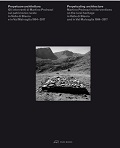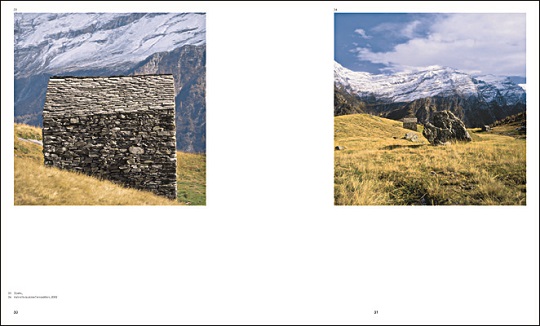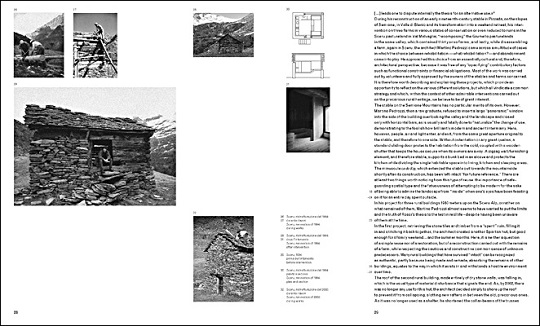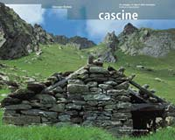Martino Pedrozzi’s Interventions on the Rural Heritage in Valle di Blenio and
in Val Malvaglia 1994–2017
For more than twenty years, Martino Pedrozzi has been working on the partial
reconstruction of derelict dwellings on alpine pastures in the mountains of
southern Switzerland. His interventions in Valle di Blenio and Val Malvaglia,
at altitudes around 6,500 feet, are part of a plan to protect and preserve the
cultivated landscape that was shaped by generations of local farmers grazing
their cattle.
Pedrozzi collected and put in place again stones that had been used as
building material for the ancient dry-stone walled structures, which have been
abandoned in recent decades. This recomposition is meant to reconstruct a
public space and to retain landmarks in the barren alpine landscape, and also
as a monument to the civilization that has lived in and been sustained by it
for centuries.
This book documents Pedrozzi’s work and highlights the problem of rural
exodus—a constant phenomenon in the history of human life, caused by conflict,
economic change, natural disasters, and climate change. It shows, strikingly,
how that exodus is manifested in this region through mountain dwellings that
are no longer used because alpine agriculture has been given up in favor of
better opportunities and more comfortable ways of life elsewhere.
Edited by Martino Pedrozzi. With contributions by Sebastiano Brandolini,
Thomas Kissling, Bruno Reichlin and Günther Vogt. Photographs by Pino Brioschi
1st edition, 2020
Text in English and Italian
Hardcover
104 pages, 5 color and 82 b/w illustrations
22 x 26.5 cm Pedrozzi’s sensitive architectural interventions on mountain
pastures highlight the topic of rural exodus in the Swiss Alps
Da oltre vent’anni Martino Pedrozzi lavora alla parziale ricostruzione di
malghe in rovina nei pascoli alpini della Svizzera meridionale. I suoi
interventi nella Valle di Blenio e nella Val Malvaglia, a un’altitudine di
quasi 2000 metri, rientrano nell’ambito di un progetto inteso a tutelare e
preservare il paesaggio coltivato plasmato da generazioni di agricoltori
locali che in quel territorio facevano pascolare il bestiame. Pedrozzi ha
raccolto e «riassemblato» le pietre che costituivano le antiche strutture
murarie realizzate a secco, da qualche decennio non più in uso. Questa
ricomposizione punta alla ricostruzione di uno spazio pubblico e alla
conservazione di elementi distintivi presenti nello spoglio paesaggio
alpestre, e vuole porsi come un monumento alla civiltà che ha vissuto in
questi luoghi da cui per secoli ha tratto sostentamento.
Questo libro documenta l’opera di Pedrozzi e richiama l’attenzione sul
problema dell’esodo rurale, un fenomeno costante nella storia della vita umana
provocato da conflitti, ragioni economiche, catastrofi naturali e cambiamenti
climatici. Mostra in modo suggestivo come i ruderi delle strutture insediative
montane presenti in questa regione siano le testimonianze di quell’esodo,
avvenuto con l’abbandono dell’agricoltura alpina per cercare altrove migliori
opportunità e modi di vita più confortevoli.
| Region | |
|---|---|
| Erscheinungsjahr | |
| Sprache | |
| Autor |
Recommendations on the topic
Documentations
Art / Culture







